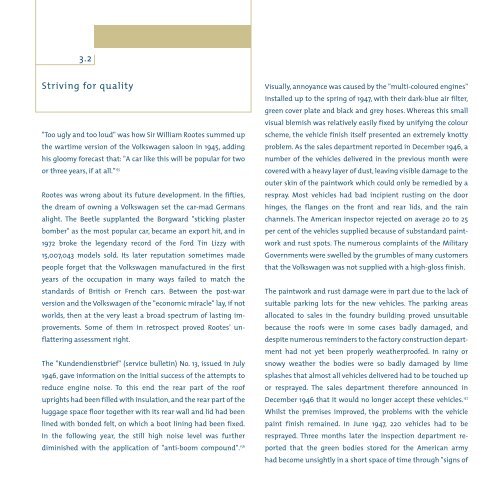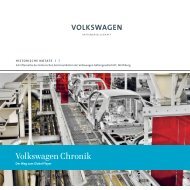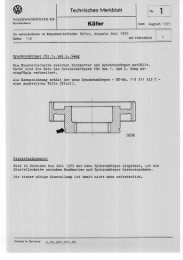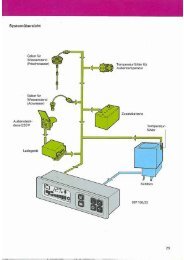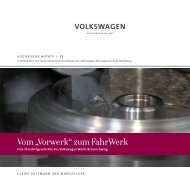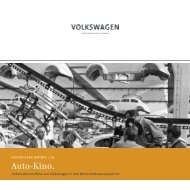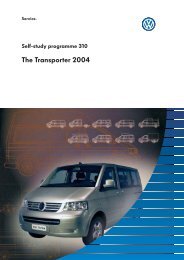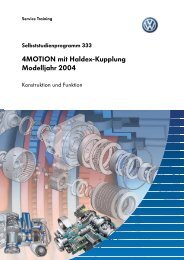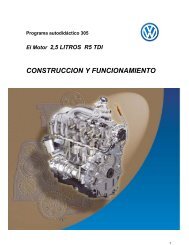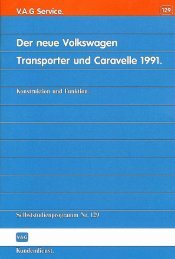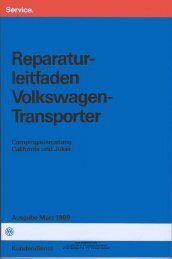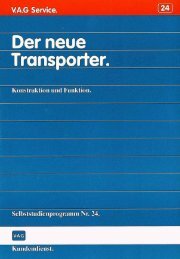HN 2: The British and their Works
HN 2: The British and their Works
HN 2: The British and their Works
Create successful ePaper yourself
Turn your PDF publications into a flip-book with our unique Google optimized e-Paper software.
3.2<br />
Striving for quality<br />
"Too ugly <strong>and</strong> too loud" was how Sir William Rootes summed up<br />
the wartime version of the Volkswagen saloon in 1945, adding<br />
his gloomy forecast that: "A car like this will be popular for two<br />
or three years, if at all." 155<br />
Rootes was wrong about its future development. In the fifties,<br />
the dream of owning a Volkswagen set the car-mad Germans<br />
alight. <strong>The</strong> Beetle supplanted the Borgward "sticking plaster<br />
bomber" as the most popular car, became an export hit, <strong>and</strong> in<br />
1972 broke the legendary record of the Ford Tin Lizzy with<br />
15,007,043 models sold. Its later reputation sometimes made<br />
people forget that the Volkswagen manufactured in the first<br />
years of the occupation in many ways failed to match the<br />
st<strong>and</strong>ards of <strong>British</strong> or French cars. Between the post-war<br />
version <strong>and</strong> the Volkswagen of the "economic miracle" lay, if not<br />
worlds, then at the very least a broad spectrum of lasting improvements.<br />
Some of them in retrospect proved Rootes’ unflattering<br />
assessment right.<br />
<strong>The</strong> "Kundendienstbrief" (service bulletin) No. 13, issued in July<br />
1946, gave information on the initial success of the attempts to<br />
reduce engine noise. To this end the rear part of the roof<br />
uprights had been filled with insulation, <strong>and</strong> the rear part of the<br />
luggage space floor together with its rear wall <strong>and</strong> lid had been<br />
lined with bonded felt, on which a boot lining had been fixed.<br />
In the following year, the still high noise level was further<br />
diminished with the application of "anti-boom compound". 156<br />
Visually, annoyance was caused by the "multi-coloured engines"<br />
installed up to the spring of 1947, with <strong>their</strong> dark-blue air filter,<br />
green cover plate <strong>and</strong> black <strong>and</strong> grey hoses. Whereas this small<br />
visual blemish was relatively easily fixed by unifying the colour<br />
scheme, the vehicle finish itself presented an extremely knotty<br />
problem. As the sales department reported in December 1946, a<br />
number of the vehicles delivered in the previous month were<br />
covered with a heavy layer of dust, leaving visible damage to the<br />
outer skin of the paintwork which could only be remedied by a<br />
respray. Most vehicles had bad incipient rusting on the door<br />
hinges, the flanges on the front <strong>and</strong> rear lids, <strong>and</strong> the rain<br />
channels. <strong>The</strong> American inspector rejected on average 20 to 25<br />
per cent of the vehicles supplied because of subst<strong>and</strong>ard paintwork<br />
<strong>and</strong> rust spots. <strong>The</strong> numerous complaints of the Military<br />
Governments were swelled by the grumbles of many customers<br />
that the Volkswagen was not supplied with a high-gloss finish.<br />
<strong>The</strong> paintwork <strong>and</strong> rust damage were in part due to the lack of<br />
suitable parking lots for the new vehicles. <strong>The</strong> parking areas<br />
allocated to sales in the foundry building proved unsuitable<br />
because the roofs were in some cases badly damaged, <strong>and</strong><br />
despite numerous reminders to the factory construction department<br />
had not yet been properly weatherproofed. In rainy or<br />
snowy weather the bodies were so badly damaged by lime<br />
splashes that almost all vehicles delivered had to be touched up<br />
or resprayed. <strong>The</strong> sales department therefore announced in<br />
December 1946 that it would no longer accept these vehicles. 157<br />
Whilst the premises improved, the problems with the vehicle<br />
paint finish remained. In June 1947, 220 vehicles had to be<br />
resprayed. Three months later the inspection department reported<br />
that the green bodies stored for the American army<br />
had become unsightly in a short space of time through "signs of


